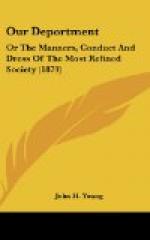BLISTERS ON THE FEET.
People who walk much are frequently afflicted with blisters. The best preventative of these is to have easy, well-fitting boots and woolen socks. Should blisters occur, a very good plan is to pass a large darning-needle threaded with worsted through the blister lengthwise, leaving an inch or so of the thread outside at each end. This keeps the scurf-skin close to the true skin, and prevents any grit or dirt entering. The thread absorbs the matter, and the old skin remains until the new one grows. A blister should not be punctured save in this manner, as it may degenerate into a sore and become very troublesome.
CHILBLAINS.
To avoid chilblains on the feet it is necessary to observe three rules: 1. Avoid getting the feet wet; if they become so, change the shoes and stockings at once. 2. Wear lamb’s wool socks or stockings. 3. Never under any circumstances “toast your toes” before the fire, especially if you are very cold. Frequent bathing of the feet in a strong solution of alum is useful in preventing the coming of chilblains. On the first indication of any redness of the toes and sensation of itching it would be well to rub them carefully with warm spirits of rosemary, to which a little turpentine has been added. Then a piece of lint soaked in camphorated spirits, opodeldoc or camphor liniment may be applied and retained on the part. Should the chilblain break, dress it twice daily with a plaster of equal parts of lard and beeswax, with half the quantity in weight of oil of turpentine.
THE TOE NAILS.
The toe-nails do not grow so fast as the finger-nails, but they should be looked after and trimmed at least once a fortnight. They are much more subject to irregularity of growth than the finger-nails, owing to their confined position. If the nails show a tendency to grow in at the sides, the feet should be bathed in hot water, pieces of lint introduced beneath the parts with an inward tendency, and the nail itself scraped longitudinally.
Pare the toe-nails squarer than those of the fingers. Keep them a moderate length—long enough to protect the toe, but not so long as to cut holes in the stockings. Always cut the nails; never tear them, as is too frequently the practice. Be careful not to destroy the spongy substance below the nails, as that is the great guard to prevent them going into the quick.
CORNS.
It is tolerably safe to say that those who wear loose, easy-fitting shoes and boots will never be troubled with corns. Some people are more liable to corns than others, and some will persist in the use of tightly-fitting shoes in spite of corns.




